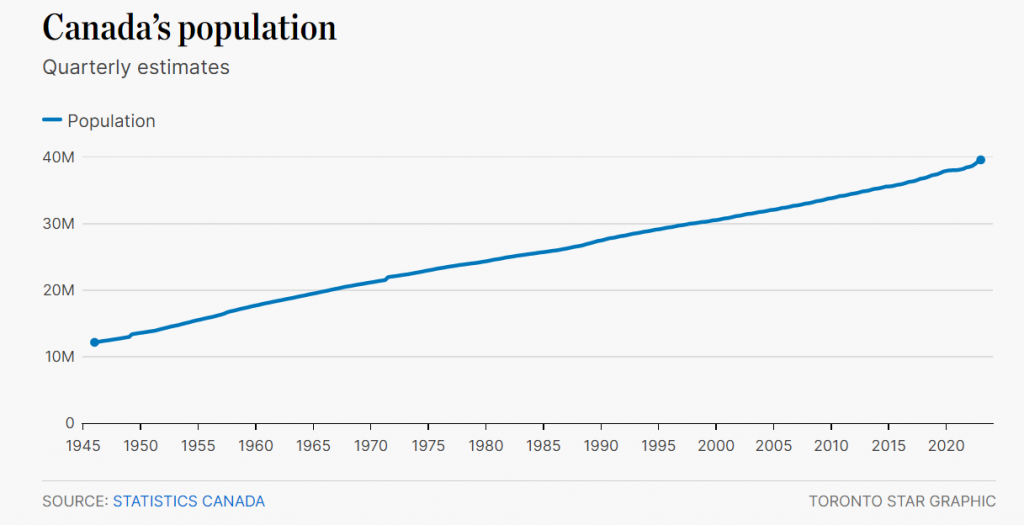Believe it or not, Canada’s population will hit 40 million in June. It’s time we learned how to retain newcomers
As published by the Toronto Star
Canada’s population is about to break the 40 million mark this June.
Chief Statistician Anil Arora took to the stage last week to illustrate Canada’s surging society, and that number was his starting point for a very good reason.
Canada’s population is growing quite quickly by historical standards and compared to the rest of the world, and almost all of that growth is thanks to immigration. At the same time, it’s important to note that in any given year, there are thousands of Canadians who leave the country — either permanently or temporarily. You can actually see it happening in real time, thanks to a “population clock” built by Statistics Canada, which shows a couple thousand people per day coming into Canada mainly as immigrants or non-permanent residents.
And what’s true for the country is even more so for the GTA, the centre of the country’s vibrant and dynamic diversity.
The implications are far-reaching and profound, as Arora pointed out in the prestigious, annual Manion lecture to public servants — especially for the economy.

To make the obvious point, it’s essential that policymakers and employers alike anticipate the change coming at us, and make the most of it. That’s not lost on any employer desperately trying to fill job postings these days, nor is it lost on our political leaders.
Immigration Minister Sean Fraser and his entourage are travelling the country, looking for bold ideas for the long term, practical ideas for the short term, and tight timelines to deliver a new vision to his colleagues in cabinet.
At stake is our standard of living, our ability to compete with other countries, our regional development and, importantly, our ability to get along with one another.
Here are a few more numbers to add to Arora’s headline.
Last year, permanent residents coming into Canada reached a historic high, and the same goes for temporary workers. In other words, Canada has a healthy flow of people moving here for the long term, along with a more haphazard intake of stopgap workers whose future is uncertain.
Employers are scrambling to fill more than 731,000 positions right now, but this is down from the one million job vacancies that dominated the news last fall. The vacancies reflect an underlying labour shortage in Canada as the population ages and retirements pile up. But layered on top of that is an expected shorter-term slowdown in hiring as the country’s employers grapple with rising interest rates and stagflation.
House prices in the GTA were up four per cent in April but down 7.8 per cent from a year ago. Similarly, the volume of sales was up nine per cent on the month, but down 5.2 per cent compared to a year ago. In other words, Toronto homes are really expensive and the market is very much in flux. It’s a confusing array of short-term mismatches and long-term demographic trends that require a nuanced approach, if the country’s economy is to set itself on a growth trajectory.
There’s no doubt that we need a growing labour force over the long term, and that immigration is the source of that growth. There’s also no doubt that business leaders routinely list labour supply as their top challenge, and they’re constantly reassessing the mix of skills that they need. There’s no doubt that the challenge of expensive housing repeatedly throws a wrench in the best-laid plans. And there’s also no doubt that Canada’s reputation as a magnet for the world’s best and brightest is under pressure because other countries are mirroring our approach and taking us on.
Canada has fallen behind on key issues that impact our reputation, including administrative backlogs, inadequate housing, and poor recognition of foreign credentials. In the 2022 Global Talent Competitiveness Index, Canada fell to 15th place — down from 9th place in 2015, with its lowest scores for immigrant retention.
Helpfully, the federal government separates out the “acute” short-term dynamics from the “chronic” longer-term pressures and is actively talking to business about how to collaborate and make sure the mix of newcomers adds to our ability to build homes, fill job vacancies and set the stage for longer-term productivity.
There’s talk of fast-tracking the flow of newcomers attached to trusted employers and trusted institutions such as universities. There’s creative thinking around how large-scale employers can work together to recruit pools of workers overseas. The discussion with professional organizations to streamline credential recognition is vigorous. And there’s some promising use of technology to speed up approvals in a way that also helps with matching people with jobs and smooths out integration.
And of course, on top of the push for speed and the right mix of workers, Canada’s immigration policy is also about a humanitarian approach to refugees and family reunification, as always.
We’re in the midst of a promising collective brainstorming around how — a brainstorming that will become more complicated in the next months as government drives towards decisions and as the economy slows down.
Luckily, most of the public, the government and business are on the same wavelength in making immigration work well for the economy, and the country as a whole.
Let’s keep that consensus in mind as policymakers and employers figure out how.












